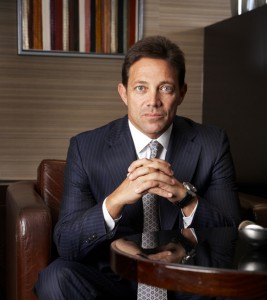Tom Pokorny was purging old documents inside his Illinois home last summer when he came across two-decades old files from his case with Stratton Oakmont.
They were a reminder of a miserable time in his life, which he was glad to finally put behind him. Pokorny hadn’t thought about Jordan Belfort, Daniel Porush and their penny stock-pushing band of misfits in a long time, and for good reason.
It “brings back bad memories,” he tells me.
He eventually decided to toss the documents.
“I try to block this out,” he admits.
Not long after trashing the files did Pokorny learn that legendary director Martin Scorsese was releasing a $100-million film called The Wolf of Wall Street starring Leonardo DiCaprio as Belfort, the founder of now-defunct Lake Success “pump-and-dump” brokerage firm Stratton Oakmont, which one prosecutor at the time dubbed “the most famous boiler-room brokerage firm in recent memory,” according to The New York Times. The film, it turns out, was inspired by Belfort’s memoir of the same name, which he penned after serving 22 months in a federal prison for securities fraud and money laundering. (As legend has it, Belfort’s cellmate Tommy Chong, of Cheech and Chong fame who’d been busted for dealing mail-order bongs, convinced the penny stock fraudster to write a book.)
Pokorny can’t recall the name of the broker who first made contact with him in November 1992 with a phone call that sent his financials plunging downward, fast. But he clearly remembers him having a distinct voice, which continues to irk him.
“I can’t stand to talk to anybody with a New Jersey accent anymore. It’s bad to say that,” he says, managing a laugh. “It was just bad memories.”
Pokorny was living in Naperville, Ill., when the obnoxious Stratton Oakmont broker first contacted him out of the blue. He was in his 30s and was running a commercial general contracting company he purchased from his father. The firm hounded him for a while before Pokorny was finally convinced to invest in an irresistible blue chip stock, Stratton Oakmont’s modus operandi. His first investment with the firm doubled its return right out of the gate.
“The next thing I know, I kept on giving them more, and I was making money,” he recalls.
Everything spiraled out of control in January 1993 when the firm, unbeknownst to Pokorny, used his money to buy other stocks without his permission, he says. His calls for them to stop recklessly using his money went unheeded. Finally, he had to get his lawyer involved, a counterstrike that led to the firm mailing him a check for about $200,000.
But at that point, Pokorny was already in an $800,000 hole. Then came another crushing blow: “I ended up getting divorced over all this, too,” he says. “That was even worse.”
His is not the only story of heartbreak and financial distress caused by Belfort. The former Wall Street charlatan—partly fueled by an insatiable drug habit, he professes in the book; mostly fueled by greed and reckless criminality, counter prosecutors—tricked then bilked countless victims out of millions, according to court documents, interviews with attorneys on the case, short-changed investors and his own book. In other words, the shyster not only lied, cheated and robbed unsuspecting people, but destroyed their lives.
Louis E. Dequine, Jr., a former Golden Gloves boxing champion, got burned by Stratton Oakmont, according to his Northport-based attorney Timothy Dennin, and suffered a stroke years later under extraordinary stress. Both he and his wife have since died.
“He had been persuaded to take his money out of the brokerage firm where he’d had a very long-term relationship and put it with Stratton Oakmont,” his son Dr. Louis E. Dequine III told the Times. “I remember thinking, ‘Oh gosh, he’s finally getting old enough where people are taking advantage of him.’ ”
When Hollywood’s elite gathers for the 86th Academy Awards on March 2 to recognize the top films of 2013, among the nominees for Best Motion Picture of the Year will be Scorsese’s The Wolf of Wall Street. It also secured nominations in several other prestigious categories, including Best Performance by an Actor in a Leading Role for DiCaprio’s depiction of Belfort, who had received close to $1 million for the rights to his memoirs. The film, which grossed $113 million domestically as of Feb. 25, grabbed a total of five Oscar nominations.

The film focused much of its attention on the drug-addled debauchery and testosterone-fueled romps and lavish parties, which almost always involved prostitutes and insane amounts of cocaine and other drugs, like Quaaludes, Belfort’s favorite. It failed, critics say, to portray the rotten way in which Belfort and his hooligans (“Strattonites,” as they’re called in his book) scammed people into throwing away hundreds of thousands of dollars for their own benefit. And by deciding not to offer a glimpse into the real-life implications of their fraud, they are glamorizing the serious crimes that led to some investors losing considerable portions, if not all, of their life savings, victims of the scam and those close to the original case charge.
What’s playing out in real life at this very moment, however, could have far greater implications for the 1,513 victims recognized by the government.
Nearly eight years since the self-professed “Wolf” was released from prison on April 28, 2006, only $11,629,143.64 has been repaid toward a court-imposed restitution totaling $110,362,993.87. The bulk, prosecutors and court documents say, has come from the liquidation of some of Belfort’s and Porush’s properties that the conniving duo forfeited as part of a plea deal.
Many victims who have tried to put Belfort behind them, like Pokorny has attempted to do, may be shocked to learn that prosecutors are currently involved in ongoing discussions regarding Belfort’s restitution. Last October the U.S. Attorney for the Eastern District of New York moved to declare Belfort in default. Then they withdrew the motion following a sharp rebuke from the disgraced ex-con’s attorneys—who criticized the government’s letter for mischaracterizing the facts in the case. They’ve also argued that the former head of Stratton Oakmont was only obligated to pay 50 percent of his gross income until his period of supervised release ended in 2009. Belfort, for his part, has offered to turn over 100-percent of the proceeds from both books and the film, according to his lawyers and public comments he has made. The government, Belfort’s attorneys say, rejected that offer.
In layman’s terms, Belfort is manipulating the legal system to stall, in an attempt to get out of repaying the people he ripped off so severely.
“They’re in talks to find a resolution and seek a way for the victims in this case to get the restitution that they were granted by the court,” Robert Nardoza, the spokesman for the U.S. Attorney’s office in Brooklyn, tells the Press. He declined to explain why negotiations are necessary despite the court-imposed restitution, and he didn’t comment on Belfort’s attorneys’ claims regarding his client’s obligations.
Victims have no problem calling it as it is, however.
Robert Shearin, a Stratton Oakmont victim who lives in Manhattan Beach, Calif., which borders Hermosa Beach, the waterfront community where Belfort now lives, isn’t optimistic that he and other victims will ever be fully compensated.
“The reality is the losses were real, the criminality was real, and I don’t think his compunction is real,” he tells the Press. “Or else he wouldn’t have been fighting this whole restitution order and have so little come into the fund.”

Wolf in Sheep’s Clothing
Joel Cohen was the assistant United States attorney who prosecuted the case against Belfort and Porush, which led to a grand jury indicting the pair in September 1998, according to court records.
For years federal prosecutors had been investigating Stratton Oakmont, which ran its high-intensity boiler room operation out of a large office building on Marcus Avenue in Lake Success, but the investigation that eventually led to the charges of securities fraud and money laundering really began in earnest around 1997, Cohen tells the Press. Investigators had previously attempted to go after lower-level Stratton workers by charging them with a crime and hoping that they’d turn on their bosses. But the firm was tight-knit, and brokers on the floor weren’t members of Stratton’s close inner circle. So, they pushed on.
Their probe led them to Switzerland, where investigators were able to convince Swiss authorities to hand over documents naming both Belfort and Porush.
“That was the moment we knew we really had it,” Cohen recalls.
Belfort and Porush were both arrested on the same day, but at the time, neither of them was aware that the other was in custody. Prosecutors used that to their advantage. They interviewed Belfort while he was out on $10 million bail and sat down separately with Porush, who remained behind bars for several months following his arrest.
“We always felt like we needed to confirm everything [Belfort] said because he’s a salesman,” Cohen explains. “There’s never a moment when you can be sure whether he’s being genuine or not; you’d have to confirm it all.”
The tight-lipped Belfort that moviegoers were introduced to in Scorsese’s film isn’t at all the same man who wilted under pressure when the feds had him pinned. Never did he attempt to save Porush—or anyone for that matter—by revealing he was wearing a wire—which is depicted in the film and makes Belfort out to be a loyal protector of their collective sins.
“[Belfort] flipped on him within 36 hours,” Cohen says. (Translation: Belfort was more of a rat than a wolf.)
The probe culminated with the greedy duo both copping pleas for reduced sentences.
There was also the fiery scene that played out in the Stratton Oakmont broker room floor when the filmmakers, apparently trying to bolster their mythical depiction of the Quaalude-popping philanderer, made it seem as if Belfort refused to settle with the U.S. Securities and Exchange Commission (SEC).
“That never happened,” Cohen says, bluntly.
In the real world, Belfort has claimed that Stratton Oakmont targeted wealthy investors, but Cohen says the firm’s victims “ran the gamut.”
“Some of them were wealthy, some of them were not,” he says. “Obviously you have to have enough disposable money to be able to take calls from a broker and invest it, but there were people that invested fifty or a hundred thousand dollars and a considerable portion of their life savings or their children’s college fund or their pension money. So there were many people who lost a sizable amount of their income. Belfort would like you to think that this is just rich people who were throwing money away and don’t feel sorry for them, but they weren’t.”
Diane Nygaard, a Kansas City, Miss.-based attorney, represented or spoke to more than two-dozen Stratton Oakmont victims who invested hundreds of thousands of dollars.
The first call from Stratton Oakmont broker was fairly polite and serious, Nygaard tells the Press.
“You’d invest in the stock and you’d get your statement and it would’ve tripled in a month and you’d get your next statement and it’s up more,” she says. Before investors knew what was going on, “The guy’s calling you and tells you, ‘You better buy more, it’s going to go public pretty soon,’ ” she continues.
“Once the money walked in the door, it’s like the No-Tel Motel, it’s not going to come back out,” she says, adding: “None of my clients have received any money from any voluntary restitution payment made by Belfort or Porush. Nothing.”
Dennin, the Northport attorney, represented about 20 victims himself—he estimates to have recovered money for half his clients—and said the culture depicted in the film closely resembled life in the Stratton Oakmont broker room floor.
Young brokers, some who Belfort claimed in his book didn’t even graduate high school, were instructed to never take no for an answer, and used “scripts” to dodge all types of objections, Dennin says.
In one of the scripts Dennin obtained during his work on the case, titled “Straight Line Philosophy” (inspected by the Press; which happens to also be the name of Belfort’s current product in his motivational speaking business), brokers were told: “The introduction is the hook to catch the prospect’s interest and his attention. The first attempt might not always work, nor the second or the third, but before moving on make sure he bites.”
“Remember,” the next line screams, “the bigger the fish, the harder the fight.”
Brokers would “make representations about ‘I’m not pressuring you now but down the road if I have an opportunity there’s a stock that we may be bringing to market that’s only available to certain select investors,’ ” Dennin says. “And get them to bite. If they agree to buy, then they get all enthusiastic, then they got the room screaming.”
Eventually, scores of investors were burned for hundreds of millions of dollars.
Publicly, Belfort has stated that he’s a changed man after his prison stint. He’s now a motivational speaker and his greatest priority is “to settle his fines,” according to a letter sent from his now-fiancé to U.S. District Court Judge John Gleeson, who’s been overseeing the case since its inception.
“Jordan has turned his life around,” she wrote. “Our business and our family rely on his reputation of being an honest and honorable man.”
Neither Belfort nor his attorney Robert Begleiter, with Manhattan-based Schlam Stone & Dolan, returned a request for comment for this story.
In an interview with CNN’s Piers Morgan shortly after the movie’s debut, Belfort told the host: “I try daily to right the wrongs I committed.”
How does he feel toward his victims? “I feel terrible about what happened,” he told the host, adding that he lives not with shame, but with remorse.
His victims aren’t buying any of it.
Who’s Afraid of the Big Bad Wolf?
Dr. A.E. Vitt, 81, a retired dentist who lives in Heath, Texas, was practicing in tiny Seneca, Kan., two decades ago when Stratton Oakmont got him on the line. At the time, they were pushing Nestle stock. He was caught in the same trap as hundreds of others.
“They were very persistent,” he tells the Press. “They wouldn’t take no for an answer.”
The firm wanted more money, so Vitt ended up taking out close to $100,000 in loans from the bank just to continue his investments.
He also blames himself.
“I’m sort of a dumbass,” he says, his voice getting lower, “so it took a couple trips thinking it was good and then after that, it didn’t take long for me to figure out that I was going nowhere fast.”
Two years had gone by before he realized the firm was playing him.
Vitt, who has only been able to reclaim less than $8,000 of the quarter-million dollars that Stratton Oakmont stole from him, still decided to buy a ticket to see Belfort’s purported real life story.
“I thought it was the most vulgar and sex[ual] thing I’ve ever seen in my life,” he says from Texas. “Plus, the way he treated everybody…I thought he was a glamorized S.O.B.”
“I can’t understand why he can still get away with it,” he adds.
Shearin, the Manhattan Beach, Calif., victim, is also retired. He lost several hundred thousand dollars with Stratton Oakmont, but worked hard to make the money back—though he estimates he’s only recovered 17 percent of what he lost.
Things got heated between Shearin and his broker once he realized they were trying to pull a fast one on him.
“I would end up in screaming matches when I finally kind of figured out that I’m just getting screwed here,” he tells the Press.
“Somebody else would get on the phone and just be screaming back at me, calling me a fucking asshole and an idiot and too stupid to make money,” Shearin recalls. “Just screaming at me. So we would have these screaming matches in the middle of my work day when I’m trying to run my business… They don’t show that [in the film].”
Shearin has spotted Belfort cheering on his kid at the local soccer field. But he’s resisted the urge to approach him.
“What’s the point?” he asks. “What am I going to do? Walk up to him and ask him to please write me a check? I don’t need to be around him. He’s not in my circle of friends and I don’t want him to be.”
The Harvard Business School graduate, now 66, says his brother once told him that he serves as a cautionary tale because he should’ve had the educational background to notice someone was hustling him.
And Shearin, too, opened up his wallet to see the movie but he never intended to walk out of the theater with a better understanding of Belfort’s life.
“Going to a movie to see truth would be like going to Oliver Stone’s JFK to learn about the Kennedy assassination,” he says. “So I didn’t walk out thinking , ‘Oh, that didn’t tell the truth.’ ”
“[It was a] one-sided rollicking frolic through hedonism,” he says, “but it sure left out a lot of the story.”



























